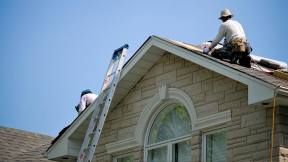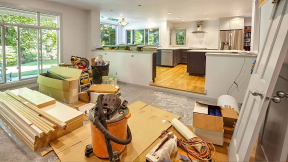Smart home devices: How technology can transform your home

Being a homeowner has its perks, like having a cozy place to decompress. Thanks to the advent of the internet and Bluetooth technology, many facets of home life have been simplified or even automated with the help of smart home devices. That robot vacuum your beloved pet has a love-hate relationship with? It’s a smart home device. The color-changing bulbs you fiddle with to set the mood? They’re also considered smart home devices. To better understand how these gadgets may change your everyday life and responsibilities, let’s take a closer look at how smart home devices function within the household.
What is a smart home?
Despite the name, smart homes may not be able to help you answer life’s greatest philosophical questions or solve any complex mathematical formulas. In this case, “smart” refers to the incorporation of technologies that allow for interconnectivity between your home’s systems and devices. A smart home will generally feature some combination of wireless or hardwired smart home systems, such as security or lighting controls, as well as smart home devices and appliances.
What are smart home devices and how do they work?
A smart home device is a wirelessly connected appliance or gadget that can use wireless technology, like internet or Bluetooth, to communicate with your other devices or smart home systems both wireless and wired. Though there are pros and cons with these devices, this greater connectivity is known as smart home integration or home automation, and generally allows you to control, for example, your lights or thermostat from your phone, whether you’re at home or on the go. When technology interfaces with physical objects in this capacity, it’s often referred to as the “Internet of Things.”
Types of smart devices
Smart devices are varied in terms of shapes, sizes and functions. While some of them, like smart speakers, may serve the whole home, others are more specific in their duties. Let’s explore some of the gadgets you may want to incorporate into your smart home:
Smart tech for the whole home
- Smart speakers: These speakers generally integrate technology that allows for voice control or operating the device from your phone. Some even feature displays or color-changing lights. People really seem to like telling their voice assistant what to do or asking it their burning questions: About 36% of Americans own smart speakers, a percentage that’s doubled since 2018.
- Smart displays: These screens do a lot more than allow you to view images. Most smart displays boast voice control, touchscreens and cameras. They’re often integrated with other smart home devices like security systems, lights and smart thermostats.
- Smart plugs: If you’re interested in making your house more energy-efficient and potentially saving money, smart plugs might be a solid addition to your smart home. Smart plugs give you the ability to turn your electronic devices on or off from your phone or with voice control. Some smart plugs allow for scheduling a device’s active time: for example, keeping your air conditioner off during the workday when nobody is home. Others let you monitor the energy consumption of your devices, allowing you to adjust usage accordingly.
Smart design solutions
- Smart lightbulbs: Thanks to smart lightbulbs, many homeowners have the ability to control their lights with a remote control, a smartphone app or voice control. That doesn’t just mean you’re able to turn them off from a room away. These bulbs often come with multiple color settings and dimming capabilities, which could help you set the mood for a variety of fun occasions. As a bonus, smart lightbulbs generally use LED technology, which is considered to be more energy-efficient than traditional bulbs or fluorescent lighting.
- Smart blinds: Smart blinds use wireless technology that allows you to control their function with the power of your voice or a phone app. This comes in handy in situations where you want privacy — fast — or need to reduce glare when you’re sitting in front of a screen.
Smart security solutions
- Smart locks: From enhanced security and surveillance to convenience, smart locks offer a range of potential benefits, like offering keyless entry. Many smart locks also allow you to select a custom code that may make it easier for family, friends or your dog-walker to enter when you’re busy or not at home.
- Video doorbells: These smart home devices combine the classic function of a doorbell with more advanced technology, allowing you to monitor any events that occur at your doorstep. This could help you know exactly when your much-awaited packages have arrived or allow you to communicate with an unexpected guest via the built-in microphone and speaker some video doorbells are equipped with.
- Smart alarms: Like video doorbells, smart alarm systems allow you to monitor your home whether you’re on the couch or away at work. While they may come equipped with camera and video capabilities, smart alarms often use wireless sensors that detect motion, smoke or liquids, and will alert you when something isn’t quite right.
- Pet cameras: Whether you or your pet suffer from separation anxiety or you’re extra concerned with pet safety, these cameras can help you keep an eye on your furry, scaled or fishy friends while you’re at work or on vacation. These cameras sometimes come with features beyond monitoring, like treat dispensers and interactive toys to keep your pets busy if they’re on their own.
Smart home comfort
- Smart thermostat: With remote access, smart thermostats allow you to control the comfort levels of your home from any location. Some smart thermostats even have learning capabilities that allow them to recognize your schedule or automatically adjust to your preferences over time. This could help you save energy and on energy bills, depending on the way you use your thermostat.
- Smart humidifier: Humidity is a key component of comfort, whether you live in an arid region or the middle of a jungle. Smart humidifiers are a convenient and often efficient way to control just how dry or humid your space is, from any location. In addition to remote control, some smart humidifiers work on a set schedule or alert you when a filter needs to be replaced. Monitoring these devices and adjusting use could also help you lower your energy bills.
Smart kitchen
- Smart refrigerators: If you’re prone to forgetting your grocery list at home, some smart refrigerators may track inventory or alert you when that milk expires before you pour it into your morning coffee.
- Smart dishwashers: Forget to run the dishwasher ahead of a dinner party? Smart dishwashers have got you covered. These devices have a range of features, from remote-controlled functionality to alerting you when it’s time to clean the filter or schedule maintenance.
- Smart ovens: The remote capabilities of smart ovens allow you to monitor your cooking from afar or even preheat (or shut off) your oven while you’re on the go. Other common smart oven features include temperature control and recipe integration, which may help you with some cooking tips or automatically adjust your oven’s settings based on where you are in the cooking process.
- Smart cooking devices: Cooking has come a long way since our ancestors invented fire, and smart cooking devices range from sous vide contraptions to air fryers and electric slow cookers. These devices are designed to up your cooking game or streamline the process, allowing you to monitor your project, program devices to cook on a schedule and adjust settings remotely.
Smart bathroom devices
- Smart mirrors: These mirrors may come with a range of features from built-in lights, touch screens or even displays that can give you the weather report or the latest headlines while you’re brushing your teeth.
- Smart toilets: If you’re tired of sitting down on a cold toilet seat, you may be interested in a smart toilet. With features like heated seats, bidet functions, self-cleaning and deodorizing capabilities, these devices can potentially elevate your experience when nature calls or when it’s time to clean the bathroom.
- Smart sinks and faucets: These smart home devices can help you customize water pressure and flow and shower head or faucet settings. This type of monitoring and adjustment may help you conserve water and save on your water bills.
Do smart devices make your home more energy-efficient?
While many smart device features aim to make life convenient, some smart home devices provide the added benefit of making your home more energy efficient. Being able to control and monitor any devices that use resources like electricity or water allows you to moderate your use. Knowledge is power, and the insight and control of smart home devices could help you make greener decisions regarding your house’s energy use.
In summary
As the world gets “smarter”, so can your home, giving you the ability to accomplish household tasks more conveniently, improve accessibility and energy efficiency, or simply allow you to easily set the mood for a party or a relaxing night in. While smart home devices may require a bit of an initial investment, the opportunity to automate your more banal household tasks may be worthwhile, depending on your situation.
Smart home devices: FAQs
1. How much does a smart home cost?
The cost of a smart home depends on your own specific needs. To get a better idea of what your ideal smart home will cost, take time to assess your needs and see how they align with your budget.
2. Can smart home systems be hacked?
As smart homes generally require internet connectivity, they do run the risk of being hacked. To minimize the risk, you’ll likely want to employ strong passwords, keep your devices up to date and exercise caution when downloading apps or granting any permissions to third-party apps.
3. Can I install my own smart home system?
Depending on your level of technological prowess and the number of devices and systems you’re installing, you may want to consider hiring an expert who does this for a living. They may be able to get your system up and running a bit faster, thanks to their experience.



